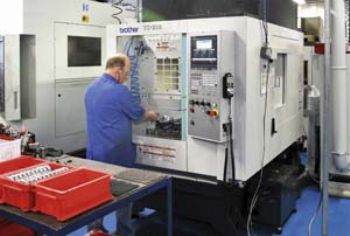
The Plymouth-based sub-contractor Morris Engineering was faced with either losing an aerospace contract — quite possibly to an overseas supplier — or finding a way of manufacturing the components more cost-effectively.
The resulting value-engineering exercise, which involved investing in an additional vertical machining centre, was so successful that cycle times and labour costs were both cut by a factor of five, reducing the cost of manufacturing the components by 50%.
Supplied by UK agent Whitehouse Machine Tools Ltd, Kenilworth (www.wmtcnc.com), the Japanese-built Brother TC-31B automatic-pallet-change (APC) machine is a 30-taper model having a 16,000rev/min spindle with through-coolant facility, a 26-pocket tool magazine, a 1.7sec chip-to-chip tool change time, a 50m/min rapid-traverse rate in X, Y and Z, and a 350 x 250 x 350mm working envelope.
While the TC-31B is of smaller capacity, less well specified and a little slower than Brother’s flagship TC-32B QT auto-pallet-changing machining centre (of which Morris Engineering has three), it is eminently capable of producing the tightly toleranced aerospace parts; and crucially — in the context of this price-sensitive application — it costs 40% less than the TC-32B. Moreover, with a 3.2 x 1.4m footprint, the machine occupies just two-thirds of the TC-32B’s footprint, which is also beneficial as space is limited at the Plymouth factory.
Four years of production

Morris Engineering started manufacturing the predecessors of the components in question for its aerospace customer in 2008 and has produced six iterations of the components over the years. At the outset, a vertical machining centre without APC was used for the work, as the three Brother TC-32B QTs were — and still are — devoted to producing microwave-antenna parts.
Production manager Matthew Mann says: “Average cycle time for the two or three operations on each aerospace component was originally around 30min, although we eventually got it down to 12min using multi-flute solid-carbide milling cutters from SGS. Manufacture was based on batches of 400 parts, but the trouble was that when parts drifted out of tolerance, hundreds of parts could be scrapped, reducing our profit on the job. “To make matters worse, the parts have been getting smaller and the tolerances tighter and more difficult to hold. The drawings now specify 10µm on hole sizes and 0.05mm on position and concentricity. Then the ‘cost down’ request came in from the customer, so we had to completely revise the manufacturing process to keep the work and make it pay.”
There had already been a move towards lean manufacture and single-piece flow at the Plymouth factory, following a request by another of the sub-contractor’s customers to go down the ‘lean route’. Production of components in one or two hits was becoming the norm wherever feasible, as was investment in twin-pallet machines to take load/unload out of the production cycle.
Turn-key installation

The Brother TC-31B was identified as being ideally specified for manufacturing the aerospace parts (instead of the 16,000rev/min spindle, a 22,000rev/min option could have been supplied). Whitehouse Machine Tools configured the machine at its Kenilworth technical centre to produce the current two pairs of parts, including writing the programs and carrying out time studies.
Two, three or four machining operations per part are required, according to the variant. Four MicroLoc fixtures on each pallet can clamp any of the four parts, cutting the time required to change over between one pair of components and the other. One component comes off complete every 6min, representing a halving of the best previous cycle time and a five-fold reduction compared with the original time.
Theoretically, two clamping positions per pallet would have been enough to enable both sides of the components to be machined. However, to improve tool access and to make it easier to hold tolerance — in particular concentricity — one or two of the cycles have been split into two, resulting in three or four operations overall for some components.
Tim Winzer, Morris Engineering’s managing director, said: “Our ability to take 50% out of the cost of manufacturing the parts, despite buying a new machine, is not down to the shorter cycles alone. Whereas before we had two operators running two machining centres over two shifts to fulfil the contract, we now have one operator looking after the TC-31B over a shift and a half.
“Our current arrangement has cut over 80% from the labour cost associated with this long-running job, so we can compete with any potential supplier world-wide for the manufacture of this type of precision component.
“We have built up the aerospace side of our business to comprise about 20% of our turnover, and we are on track to achieve the SC21 bronze award later this year. It reaffirms our commitment to advancing our position in the aerospace supply chain as a specialist manufacturer of relatively small, high-accuracy parts.”